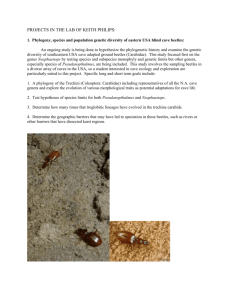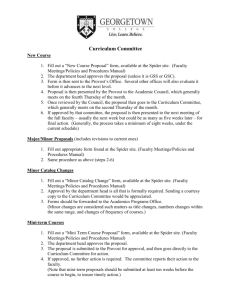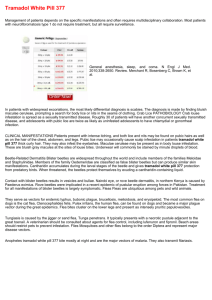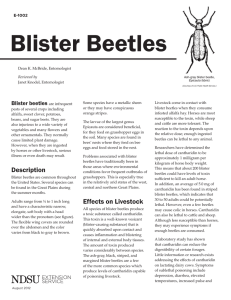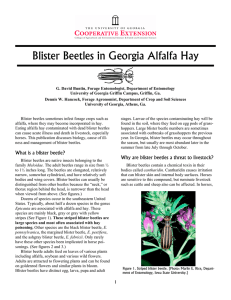Venomous Arthropods
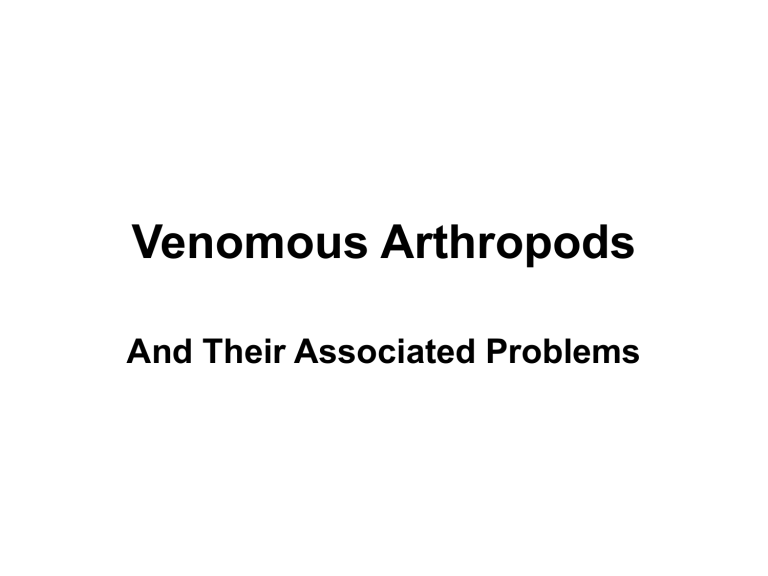
Venomous Arthropods
And Their Associated Problems
Envenomization
• Can be divided up into 2 categories:
• (1) Passive Envenomization
• (2) Active Envenomization
Envenomization - Action of Venom
• Neurotoxin (black widow spider)
• Cytolytic, hemolytic (brown recluse spider)
• Hemorrhagic (moth larvae)
• Vesicating/blistering (blister beetles)
Stingers
• (1) Honey Bee
• (2) Bald Faced Hornet
• (3) Paper Wasps
• (4) Yellow Jacket
• (5) Red Imported Fire Ant
(Solenopsis invicta)
• (6) Scorpions
Venomous Hymenoptera
Red Imported Fire Ant
Fire Ant Mounds
Red Imported Fire Ants
The pathognomic pustules following a fire ant envenomation.
Velvet Ants “Cow Killers”
Scorpions
• Scorpions are easily distinguished from other arachnids by their large, well developed claws and distinct division of the abdomen into a broad preabdomen and narrow, tail-like postabdomen.
• All scorpions are venomous, but only about 25 species worldwide possess venom of sufficient toxicity to kill humans
• The venoms with severe toxicity are usually neurotoxins.
• (1) Spiders
– Black Widow
– Brown Recluse
– Hobo Spider
• (2) Centepedes
Bites
SPIDERS
Brown Recluse
Fiddle
Hourglass
Tarantula
Black Widow
Hobo
Latrodectus mactans
(Black Widow)
Loxosceles reclusa
(Brown Recluse)
Progression of Bite (3-10 days)
Tegenaria agrestis
(Hobo Spider or Aggressive House Spider)
Hobo Spider Bites
Distribution of venomous spiders causing necrotic ulceration - United States and Canada.
Lycosa tarantula (Wolf Spider)
• Occur in Europe and not the U.S.
• Not a Tarantual!
• 1370 recorded biting humans.
• Tarantism
• Dance called the tarantella
Tarantulas
• 840 described species
• Fangs larger than those of most venomous snakes.
• Old world species more venomous than new world species.
• Neurotoxic
• Most species are harmless!
Centepedes
• Class: Chilopoda
• 20 families and over
2500 species.
• 1-pair of legs per body segment.
• Most small, a few are
10 inches or longer.
• 1 st pair of legs are modified fangs.
Scolopendra gigantea
Other Methods
• (1) Millipede
• (2) Blister Beetles
• (3) Bombardier Beetles
• (4) Caterpillars (Moths)
Millipedes - Class Diplopoda
• Millipedes (2 legs/body segment) do not have biting mouthparts or fangs. Their medical importance comes from their ability to secrete an irritating defensive liquid from pores along their sides.
• Such secretions contain benzoquinones, aldehydes, hydrocyanic acid, and other substances.
Blister Beetles
• Family: Meliodae
• Cantharidin
• Livestock come in contact with blister beetles .
• Spanish Fly
Bombardier Beetles
• Family: Carabidae
• ½ inch long.
• Chemical defense
• 70 rapid shots
• 100C (212F)
• Southern California
Bombardier Beetles
Venomous Insects - Lepidoptera
Problems Caused by Adult Moths
• Dermatitis
• Respiratory Distress (Asthma)
• Lachrymal and blood-feeding
Problems Caused by Larval Moths
• Dermatitis
• Stinging envenomization - allergy
• Hemorrhagic manifestations
Larval Moths Known to Cause
Problems to Humans
• Urticating or "stinging" spines and setae.
• Average sensitivity
– stinging sensations
• Extreme sensitivity
– Severe pain and allergic reactions.
– Cases are known of hospitalization
– Skin bleeding (poison spines containing an anticoagulant)
Lonomia electra
[Costa Rican species]
Puss Caterpillars
• Megalopyge opercularis
• Florida Species
• long, silken, brownish hairs.
• short, poisonous spines.
• burning sensation, as painful as a bee sting.
Puss caterpillars.
The caterpillar at the left is fully grown; the one at right is still developing, note the recently shed
(and still urticaceous) skin beside the larva.
Saddleback Caterpillar
Sibine stimulea
The io moth
Automeris io
[Costa Rica]

